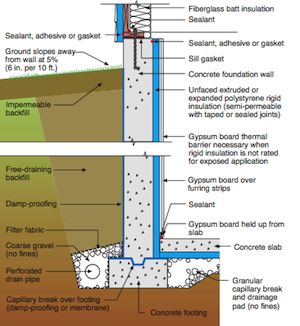Basement Insulation

Basement Insulation Recommendations Per Zone
When it comes to insulating a home, most people probably envision rolls of insulation in the attic and walls, and that would make total sense as those areas are critical in the design of a efficient green home.
But there's another part of the house that requires just as much, if not more, attention as these other spaces, one that doesn't always get considered when planning insulation. That area is the basement, literally the foundation of the entire house.
Consider this: an uninsulated concrete basement foundation can account for 25 percent of a home's total heat loss, even in a home that is well-insulated in all other areas.
The r-value of a typical 8 inch thick concrete foundation wall is only 1.4.
Given it's large mass, a concrete foundation with this low level of insulating efficiency makes it a great candidate for supplemental insulation.
Enclosing the concrete foundation within the home's thermal envelope by adding insulation will greatly reduce a home's heat loss, and will also add beneficial moistureproofing, which is another important factor to consider.
Exterior Basement Foundation Insulation Pros and Cons:
Insulation can easily be installed during new home construction on the exterior of the foundation wall. Builders typically have applied asphalt-based coatings to the exterior of foundation walls to seal against moisture, but using a rigid foam board made from extruded polystyrene insulation, which is very tough and completely waterproof, will serve the same purpose as well as reducing heat loss through the foundation. A rigid foam insulation on the exterior foundation wall will also protect the foundation from the effects of free-thaw cycles in extreme climates, reduce the potential for condensation on basement walls and floors, and save space in the interior basement areas.
Exterior basement wall insulation does have some drawbacks. It can be very expensive for an existing home, and requires a perimeter drainage system be installed, further driving up costs. Many exterior basement insulation materials are susceptible to insect damage, and may be against building codes in some areas. For these reasons, installing interior basement insulation may be the better solution.
Interior Basement Foundation Insulation Pros and Cons:

Basement Insulation Building Section
As mentioned, adding interior basement insulation to an existing home is much less expensive than exterior insulation. Installing the insulation on the interior of the basement wall will also make it immune to bugs.
Interior basement insulation typically comes in the form of rigid foam board installed between the concrete basement wall and the interior drywall.
Putting basement insulation on the interior of the foundation wall will not protect the concrete from moisture infiltration like exterior insulation will, so some type of exterior treatment will still be necessary to moisture-proof the wall.
Basement Insulation: How Much Do I Need?
While any insulation in the basement and foundation of a home will provide energy savings, the amount needed will vary depending on the climate zone the home is in. The International Energy Conservation Code has the following requirements for basement insulation:
Energy Star Basement Insulation:
Here is a complete commentary on Basement Insulation published by The U.S. Government website EERE, which is the Energy Efficiency and Renewable Energy division. Basement Insulation Systems.
Superior Walls Foundation Systems
Read more about the Superior Walls pre-cast, insulated concrete foundation panels HERE.
comments powered by Disqus

























































































































































































